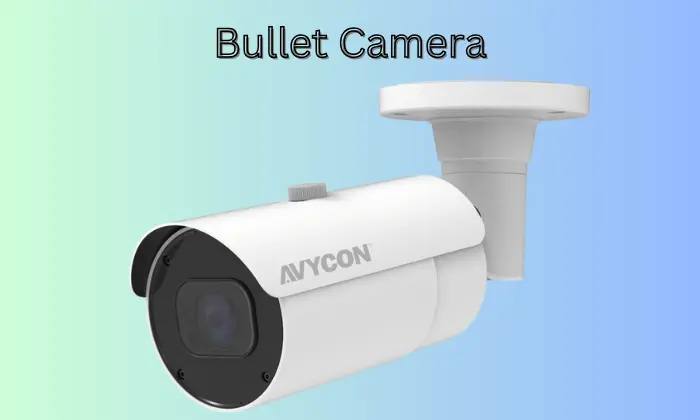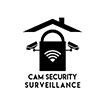Choosing the right type of camera is crucial for effective security in surveillance systems. One popular choice is the bullet camera, known for its distinctive cylindrical shape and robust outdoor performance. But what exactly is a bullet camera, and what makes it different from other types of surveillance cameras? This guide covers bullet cameras, including their types, uses, benefits, and important factors to consider when purchasing one.
What is a Bullet Camera?

A bullet camera is a long, cylindrical video camera. It resembles a bullet shell, which is why people named it that.
These cameras are often used for outdoor security. They are strong and can hold bigger lenses. This helps them capture more detail from far away. They are easily recognizable and offer a visible deterrent against criminal activities like vandalism and theft. Bullet cameras come in various sizes, including standard and mini versions, to cater to different surveillance needs.
Key Features of Bullet Cameras
Longer Form Factor:
The long casing of bullet cameras lets them use bigger lenses. This helps them take clear pictures from far away. This makes them ideal for monitoring large outdoor areas like parking lots, airports, and traffic intersections.
Weatherproof Design:
Manufacturers design most bullet cameras to handle tough weather. They have water-resistant and weatherproof ratings like IP65, IP66, or IP67. Some models even include integrated heaters and temperature gauges for extreme weather environments.
Night Vision Capabilities:
Bullet cameras have infrared (IR) illuminators. This feature gives them better night vision. They can capture clear footage in low light or total darkness. This feature is particularly useful for monitoring large outdoor areas after dark.
Easy Installation:
Bullet cameras have handles for easy installation on walls, ceilings, or special brackets. They also allow flexible positioning, so you can easily adjust the camera to cover the desired area.
High Resolution:
Bullet cameras come in different resolutions, from 2MP (1080p) to 4K (8MP), providing clear and detailed video footage. Higher resolution options are ideal for applications like license plate recognition (LPR) and facial recognition.
Types of Bullet Cameras
Bullet cameras come in several types, each designed for specific surveillance needs. Here are some of the most common types:
Mini Bullet Cameras:
These are smaller versions of standard bullet cameras, designed for monitoring shorter distances while offering a wider viewing angle. Mini bullet cameras are ideal for areas like entrances, hallways, and smaller outdoor spaces. Despite their compact size, they are easy to install and offer flexible positioning options.
Pan-Tilt-Zoom (PTZ) Bullet Cameras:
PTZ bullet cameras let users change the zoom and direction from a distance. This makes them great for watching large areas. People often use these cameras in parking lots and outside large buildings for a wide and flexible view.
Outdoor Bullet Cameras:
Specifically designed for outdoor use, these cameras are built to be weather-resistant and can handle various environmental conditions. They are ideal for monitoring parking lots, building perimeters, and other outdoor areas. However, their exposed mounting arms can make them more susceptible to tampering.
IP Bullet Cameras:
IP (Internet Protocol) bullet cameras connect to a network, either through Ethernet cables or wirelessly via WiFi. They provide high flexibility and integrate into cloud-based storage systems, allowing users to access footage remotely. However, they may have potential vulnerabilities if not properly secured.
Analog Bullet Cameras (CCTV):
Also called bullet CCTV cameras, these analog cameras send video to digital video recorders (DVRs) using coaxial cables. While considered secure, they require direct connections and may involve complex wiring setups.
Common Applications of Bullet Cameras
Bullet cameras are used in many places. They have a unique shape and are strong.
They offer many features for different security needs. They can give clear video from far away. They work well in bad weather. Their strong presence helps keep people safe. This makes them a great choice for security inside and outside. Here are some of the most common applications of bullet cameras:
- Parking Lots
- Airports
- Traffic Intersections
- Hallways
- Schools
- Hotels
- Manufacturing and Construction Sites
- Gas Stations
- Hospitals
- Libraries
Parking Lots:
Parking lots are large open spaces that require wide-area coverage and long-range visibility. Bullet cameras have a long shape that can hold bigger lenses and strong infrared (IR) lights. This helps them capture clear footage from far away. This makes them highly effective for monitoring vehicles, pedestrian movements, and any suspicious activities in parking areas, especially at night. The visible presence of bullet cameras also serves as a deterrent to potential thieves and vandals.
Airports:
Airports are high-security zones with large perimeters and multiple entry and exit points. Airports extensively use bullet cameras to monitor runways, terminals, parking lots, and other critical areas. They can see long distances and create clear images. This makes them excellent for spotting people, vehicles, and potential dangers from far away. The weatherproof design of bullet cameras also ensures reliable operation in varying weather conditions, which is crucial for 24/7 airport surveillance.
Traffic Intersections:
At traffic intersections, surveillance cameras play a vital role in monitoring traffic flow, detecting violations, and enhancing road safety. Bullet cameras are great for capturing clear video from far away, even in difficult lighting situations. You can strategically position them to cover multiple lanes, capture license plate numbers, and monitor pedestrian crossings. Some advanced bullet cameras have features like License Plate Recognition (LPR). They can also work with traffic management systems. This helps with efficient traffic monitoring and control.
Hallways and Entrances:
In indoor environments such as hallways, corridors, and building entrances, mini bullet cameras are often used. These compact cameras provide a wide-angle view that is perfect for monitoring confined spaces. You can easily mount them at strategic points to monitor entrances and exits, ensuring that you record all movements. This makes them suitable for office buildings, schools, hotels, and hospitals, where controlling access and tracking movement is crucial for safety.
Schools:
Ensuring the safety of students and staff is a top priority for educational institutions. Bullet cameras are commonly installed in schools to monitor entry and exit points, playgrounds, parking lots, and hallways. Their visible presence can help deter unauthorized access and reduce incidents of vandalism and bullying. With their weather-resistant capabilities, bullet cameras are ideal for both indoor and outdoor use, providing comprehensive security coverage across the school campus.
Hotels:
In the hospitality industry, guest safety and security are paramount. Bullet cameras are used in hotels to monitor lobbies, parking areas, hallways, and building exteriors. Their high-resolution capabilities allow for clear identification of individuals entering or exiting the premises, which is essential for maintaining a secure environment. Moreover, their noticeable presence helps deter theft, vandalism, and other potential criminal activities.
Manufacturing and Construction Sites:
Manufacturing and construction sites require the best surveillance systems to monitor large outdoor areas, loading docks, and production lines. Bullet cameras are an excellent choice for these environments due to their durable design, long-range capabilities, and ability to withstand harsh weather conditions. They can help prevent theft, monitor safety protocols, and ensure that operations run smoothly. The cameras’ high-resolution footage can also be used to review incidents, identify safety hazards, and improve workplace safety.
Gas Stations:
Gas stations are prone to theft, vandalism, and other criminal activities due to their open layout and accessibility. Bullet cameras are widely used at gas stations to monitor fuel pumps, cash registers, and parking areas. Their long-range and high-definition capabilities enable clear monitoring of all activities, while their visible presence deters potential criminals. Bullet cameras’ weatherproof features ensure reliable operation under different weather conditions, making them ideal for outdoor surveillance.
Hospitals:
In hospitals, maintaining a safe and secure environment is crucial for patients, staff, and visitors. Bullet cameras are often installed in parking lots, entrances, hallways, and other key areas within hospitals to monitor all movements and activities. Their high-resolution footage helps in identifying individuals and managing access to restricted areas. The presence of these cameras also aids in ensuring that hospital protocols and safety measures are adhered to, contributing to a secure and well-regulated environment.
Libraries:
Libraries require surveillance to protect valuable resources and ensure a peaceful environment for visitors. Bullet cameras are installed in libraries to monitor entrances, exits, aisles, and reading areas. The cameras’ high-definition footage is useful for identifying individuals and maintaining proper conduct within the premises. Additionally, the visible presence of bullet cameras deters theft and vandalism, ensuring the safety of both patrons and library materials.
Considerations When Buying a Bullet Camera
When choosing a bullet camera for your security needs, there are several factors to consider:
Resolution:
Higher resolution cameras offer more detailed footage, which is essential for applications like facial recognition or license plate capture. Based on your needs, you can choose a 2MP camera for regular surveillance. Alternatively, you can select a 4K camera for the best detail.
Lens Size and Type:
Consider the lens size based on the area you need to cover. Larger lenses provide more detail over longer distances, while smaller lenses offer wider viewing angles for closer monitoring.
Weather Resistance:
For outdoor use, ensure the bullet camera has a suitable IP rating, like IP65, IP66, or IP67. This will help it handle various weather conditions. Some models also come with heaters or temperature sensors for extreme climates.
Connectivity:
Decide between an analog or IP bullet camera based on your network setup and storage preferences. IP cameras offer remote access and cloud storage options but may require additional security measures to prevent cyber threats.
Night Vision Range:
Depending on where you plan to install the camera, consider the night vision capabilities. Longer IR ranges are best for large outdoor areas. Shorter ranges are better for indoor spaces or small outdoor areas.
Installation Location:
Ensure the camera’s design is suitable for your intended installation site. Bullet cameras with adjustable mounting brackets allow for flexible positioning and easy adjustments.
Budget:
Bullet cameras come in a range of prices depending on their features, resolution, and build quality. Determine your budget and prioritize features that meet your specific security needs.
Consider CAM Security For Security Camera Installation
CAM Security Surveillance offers a variety of Avycon bullet cameras to suit different security applications, from high-resolution 4K cameras and low-light starlight models to flexible IP cameras and advanced AI-powered options. With these diverse offerings, CAM Security Surveillance ensures that customers can find the right bullet camera for their specific surveillance needs.
Bottom Line
Bullet cameras are a versatile and effective choice for both outdoor and indoor surveillance needs. With their unique shape and strong weatherproof design, they provide a reliable security solution. They come in high-resolution options and are easy to install. These cameras work well in many places, like parking lots, traffic intersections, schools, and hospitals. Understanding the different types, benefits, and considerations will help you choose the right bullet camera for your specific application, ensuring optimal security and peace of mind.








